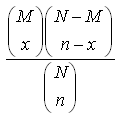Difference between revisions of "Documentation/How Tos/Calc: HYPGEOMDIST function"
From Apache OpenOffice Wiki
< Documentation | How Tos
OOoWikiBot (Talk | contribs) m (Robot: Automated text replacement %s) |
m |
||
| Line 18: | Line 18: | ||
<tt>'''HYPGEOMDIST(2; 3; 3; 6)'''</tt> | <tt>'''HYPGEOMDIST(2; 3; 3; 6)'''</tt> | ||
: returns 0.45. If an urn contains 3 red balls and 3 green balls, the probability that 2 red balls will be selected after 3 draws without replacement is 27/60 = 0.45. | : returns 0.45. If an urn contains 3 red balls and 3 green balls, the probability that 2 red balls will be selected after 3 draws without replacement is 27/60 = 0.45. | ||
| + | |||
| + | === Issues: === | ||
| + | * The forthcoming international standatd ODFF adds an extra parameter to this function, allowing the possibility to calculate the cumulative distribution function. | ||
{{Documentation/SeeAlso| | {{Documentation/SeeAlso| | ||
| Line 26: | Line 29: | ||
* [[Documentation/How_Tos/Calc: Functions listed alphabetically|Functions listed alphabetically]] | * [[Documentation/How_Tos/Calc: Functions listed alphabetically|Functions listed alphabetically]] | ||
* [[Documentation/How_Tos/Calc: Functions listed by category|Functions listed by category]]}} | * [[Documentation/How_Tos/Calc: Functions listed by category|Functions listed by category]]}} | ||
| − | |||
| − | |||
| − | |||
Revision as of 10:36, 2 March 2009
HYPGEOMDIST
Calculates values for a hypergeometric distribution.
Syntax:
HYPGEOMDIST(x; n; M; N)
- The hypergeometric distribution is a discrete probability distribution giving the probability of x successes in a sequence of n draws (without replacement) from a finite population of size N which contains M successes.
- which is
Example:
HYPGEOMDIST(2; 3; 3; 6)
- returns 0.45. If an urn contains 3 red balls and 3 green balls, the probability that 2 red balls will be selected after 3 draws without replacement is 27/60 = 0.45.
Issues:
- The forthcoming international standatd ODFF adds an extra parameter to this function, allowing the possibility to calculate the cumulative distribution function.
